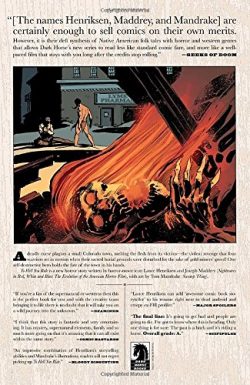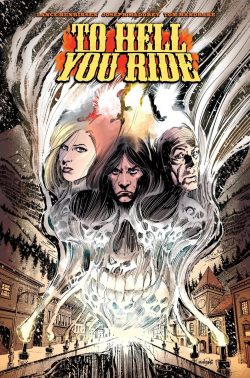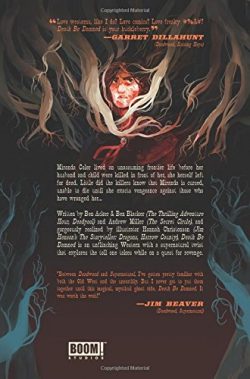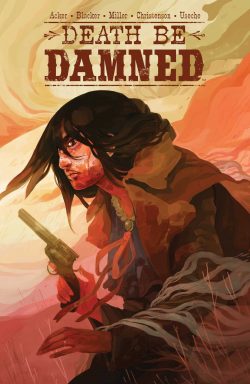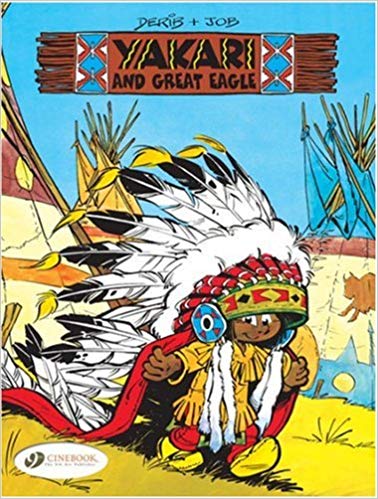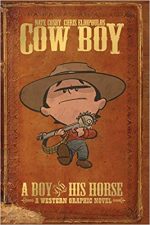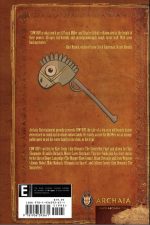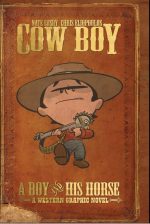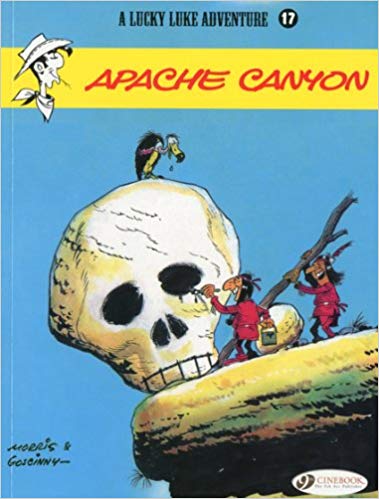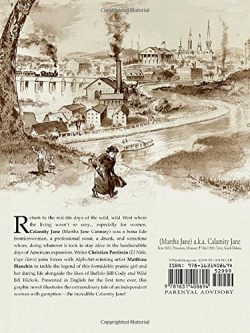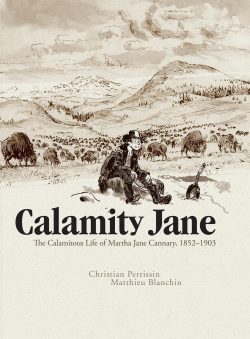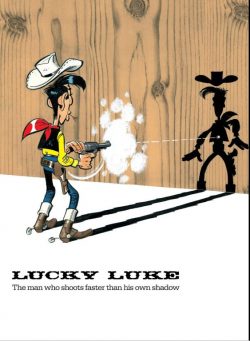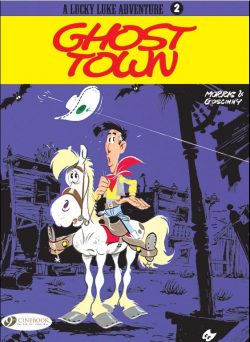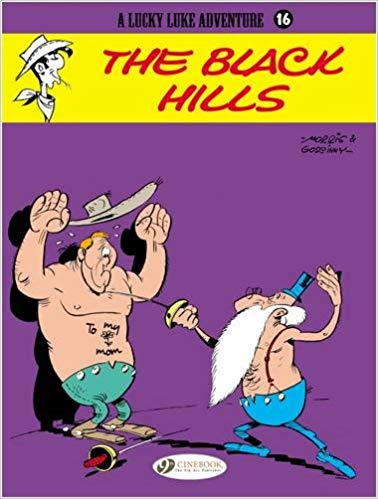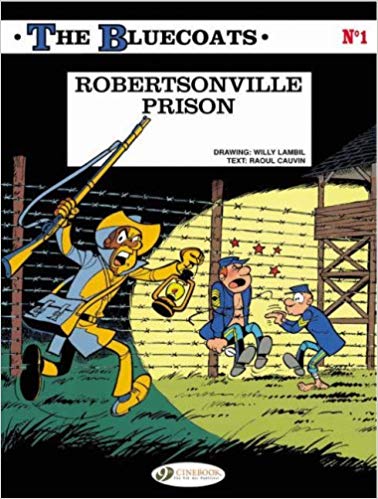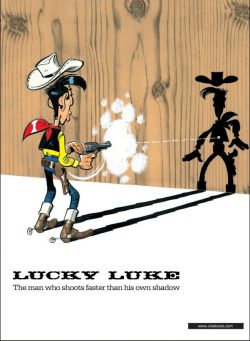
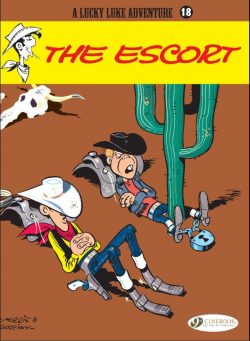
By Morris & Goscinny, translated by Luke Spear (Cinebook)
ISBN: 978-1-905460-98-4 (PB Album)
Doughty, Dashing and Dependable cowboy champion Lucky Luke is a rangy, implacably even-tempered do-gooder able to “draw faster than his own shadowâ€. He amiably roams the fabulously mythic Old West, enjoying light-hearted adventures on his rather sarcastic wonder-horse Jolly Jumper. The taciturn nomad regularly interacts with a host of historical and legendary figures as well as even odder folk in tales drawn from key themes of classic cowboy films – as well as some uniquely European ideas…
His unceasing exploits over 7 decades have made him one of the top-ranking comic characters in Europe – if not the world – generating upwards of 85 individual albums and sales totalling in excess of 300 million in 30 languages… thus far. That renown has led to a mountain of spin-off albums and toys, computer games, animated cartoons, a plethora of TV shows and live-action movies and even commemorative exhibitions. No theme park yet but who knows when…?
The brainchild of Belgian animator, illustrator and cartoonist Maurice de Bévère (“Morrisâ€) and first seen in Le Journal de Spirou‘s seasonal Annual L’Almanach Spirou 1947, Luke sprang to laconic life in 1946, before inevitably ambling into his first weekly adventure ‘Arizona 1880’ on December 7th 1946.
Working solo until 1955, Morris produced nine albums of affectionate sagebrush spoofery before teaming with old pal and fellow trans-American tourist Rene Goscinny. When he became regular wordsmith, Luke attained dizzying, legendary, heights starting with Des rails sur la Prairie (Rails on the Prairie) which began serialisation in Spirou on August 25th 1955.
In 1967, the six-gun straight-shooter switched sides, joining Goscinny’s own magazine Pilote with La Diligence (The Stagecoach).
Goscinny co-created 45 albums with Morris before his untimely death, from whence Morris soldiered on both singly and with fresh collaborators. The artist died in 2001, having drawn fully 70 adventures, plus numerous sidebar sagebrush sagas crafted with Achdé, Laurent Gerra, Benacquista & Pennac, Xavier Fauche, Jean Léturgie, Jacques Pessis and others, all taking their own shot at the venerable vigilante…
Lucky Luke has history in Britain too, having first pseudonymously amused and enthralled young readers during the late 1950s, syndicated to weekly anthology Film Fun. He later rode back into comics-town in 1967 for comedy paper Giggle, using the nom de plume Buck Bingo.
In each of these venues – as well as many attempts to follow the English-language album successes of Tintin and Asterix– Luke laconically puffed on a trademark roll-up cigarette which hung insouciantly and almost permanently from his lip. However, in 1983 Morris – amidst pained howls and muted mutterings of “political correctness gone mad†– deftly substituted a piece of straw for the much-travelled dog-end, thereby garnering for himself an official tip of the hat from the World Health Organization.
Strictly for the sake of historical veracity, that tatty dog-end has been assiduously restored for this particular tale and indeed all of Cinebook’s fare – at least on interior pages. The Canterbury-based publisher is the most successful in bringing Lucky Luke to our shores and shelves, and it’s clearly no big deal for today’s readership as we’re beyond 75 translated books and still going strong. That’s not even considering the hefty compilations of early adventures and the inclusion of spin-offs such as Kid Lucky…
L’escorte was Morris & Goscinny’s 19th collaboration, originally serialised in 1966 before becoming the 28th album release in the same year: a wittily hilarious outing incorporating a little in-story continuity as the dutiful volunteer lawman is called upon to deal with a troublesome old acquaintance…
In the very first Cinebook translation, Lucky ended the shameful depredations of juvenile delinquent and legend in the making Billy the Kid. The young offender was sentenced to 1247 years at hard labour and our hero thought the matter ended.
Now, two years later, as Lucky and Jolly Jumper show their mettle in a rodeo competition, word comes of a judicial crisis which compels the gentle gunman to take the Kid from penal servitude in Texas to stand trial for further crimes in in New Mexico…
The usually cheery champion’s patience is tested to the limits as he rides with the smug thug who takes every opportunity to terrify the populace, rile his guard and, of course, escape…
While locked up overnight in the Gun Gulch jail, Billy even gulls petty thief Bert Malloy into following them and attempt to free him on numerous occasions…
The ongoing instances of ineptitude and accidental hilarity all ultimately fail – even when Malloy recruits real outlaws to help – and eventually Billy is handed over to the authorities in Bronco Pueblo, NM and that when the real surprises begin…
Trigger-fast pacing and amply packed with set-piece slapstick and pun routines, The Escort is a potent blend of daft wit and rapid action heavy on satire and absurdity, with a brilliant sub-plot and plenty of canny twists to keeps readers guessing… and giggling.
This is another wildly entertaining all-ages confection by unparalleled comics masters, affording an enticing glimpse into a unique genre for today’s readers who might well have missed the romantic allure of an all-pervasive Wild West that never was…
© Dargaud Editeur Paris 1971 by Goscinny & Morris. © Lucky Comics. English translation © 2009 Cinebook Ltd.

